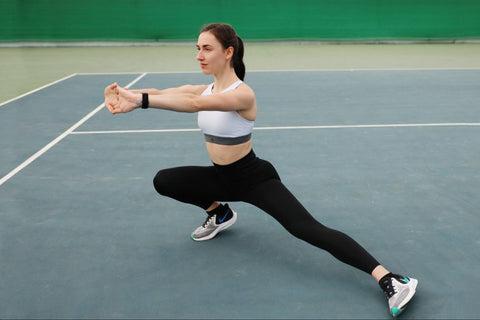A hamstring strain occurs when the hamstring muscle is stretched or torn.
Hamstring strain is a common injury in athletes and active populations, such as runners and football players. These injuries typically occur on the “up” leg (leg on the gas) while sprinting.
Are you experiencing hamstring strain? If you are and want to know more about it and learn the available treatment options for it including kinesiology tape techniques, read on!
What causes hamstring strain?
The hamstring muscles run from the pelvis down to behind the knee, hamstring injuries usually occur during activities that require running, kicking, and jumping such as sprinting, football, hockey, and soccer.
Some of the risk factors for developing hamstring strain include:
- Not warming up and/ or stretching before activity. Having tight muscles makes you more vulnerable to strain. So, warming up and stretching before engaging in any physical activity is highly advised.
Athletes should stretch before participating in exercise or sporting events to ensure muscles are elastic and have the range of motion necessary to prevent injury. Stretching should focus on the hamstring muscle group at the back of your thigh.
- Weak muscles. If your muscles are weak, they are less likely to be able to handle stress especially when exercising. Tired muscles have a lesser ability to absorb energy which makes them more susceptible to injury.
- Getting back into your activities too quickly. Getting back to your active routine too quickly without letting your hamstring injury heal fully increases the possibility of re-injury.
Hamstring injuries are caused by overusing or straining hamstring muscles while they are still weak from an injury or not fully healed. This is especially true for extreme athletes who often come back too quickly from hamstring injuries because their sport demands it.
What are the risk factors for hamstring strain?
Hamstring injuries usually occur in athletic individuals under 30 years old during sports involving sprinting, kicking, and/or rapid acceleration into running. These can include football, soccer, and hockey. Hamstring strain can also affect all age groups.
Additionally, people who have experienced hamstring strain in the past have a higher risk of developing the injury again.
How are hamstring injuries diagnosed?
Hamstring injuries are often difficult to diagnose and may require a thorough medical evaluation to rule out other hamstring injury conditions such as hamstring tendonitis or hamstring muscle strain.
In severe cases, an MRI scan will be required to see if there is a complete hamstring tendon tear or hamstring muscle retraction from the pelvic bone.
What are the three grades of a hamstring strain and its symptoms?
Sudden, sharp pain in the back of the upper leg is the most telling sign of a hamstring strain or tear. However, hamstring injuries are graded 1, 2, 3 to reflect severity.
- Grade 1. A grade 1 hamstring strain is classified as a mild stretch or tear of one or more hamstring muscle fibers without any loss of movement.
- Grade 2. Grade 2 hamstring strains are characterized by some tearing of hamstring muscles with moderate loss of range of motion and strength when:
- Walking
- Attempting to climb stairs while flexing the hamstring muscles
- Attempting to touch heels with the toes while flexing hamstring muscles
- Feeling a more intense pain around the middle part of the hamstring while contracting hamstring muscles
- Grade 3. A hamstring strain injury with grade 3 severity is classified as a complete tear of hamstring muscles, a complete loss of hamstring function, and intense pain along the hamstring muscles’ entire length.

How do you treat a strained hamstring?
Treatment of hamstring injuries include:
- RICE Protocol. The RICE protocol is effective for sports-related injuries. RICE means rest, ice, compression, elevation.
-
- Rest. Resting or taking a break from the activity may be recommended by your doctor.
- Ice. Put ice or cold packs for several minutes a day.
- Compression. Wearing an elastic compression bandage helps prevent swelling and blood loss.
- Elevation. Putting your leg up higher than your heart while resting will help reduce swelling.
- Pain relievers like NSAIDs (Non-steroidal anti-inflammatory). Drugs like Ibuprofen or Naproxen may help with discomfort and swelling. However, they should only be used in the short term since they may have side effects that include an increased risk of bleeding and ulcers.
- Kinesiology taping. Kinesiology taping offers a lot of benefits including providing support to the injured area and alleviating discomfort. It also doesn’t restrict movement, allowing you to stay active even as you wear it.
- Physical therapy. Your doctor or physical therapist may give you specific exercises to perform to improve your flexibility and strength when the discomfort and swelling have subsided.
- Surgery. For severe cases where the muscle has been torn free from the pelvis or shinbone, surgery to reattach it may be performed by orthopedic surgeons.
Hamstring injuries of any severity should not be played through due to the high risk of further injury (strains) or re-injury (tendinopathy).
If hamstring symptoms get worse with activity, this is an indicator that the strain is getting worse and immediate medical attention is required for proper diagnosis and care.
Kinesiology taping for Hamstring Strain
Kinesiology taping is increasingly becoming popular for athletes and working folks alike. If you are experiencing hamstring strain, you may try out this protocol to help with alleviating discomfort.
If you’re new to kinesiology taping, you can read about the basics here as well as the different tensions that you can use while taping.
- Have your patient in a standing position with the heel pushed firmly into the ground. This is to create a stretch and lengthen the hamstring.
- Measure and cut two short I-strip and a long I-strip. Round your edges.
- Using the long strip, anchor the tape above the area of pain. Next, apply a bit of stretch before applying the rest of the kin tape.
- Then, get the short I-strip, apply 100% tension, and place it diagonally across the area of pain.
- Get the last strip and repeat step 4 in the opposite direction. It should form an X.
- Rub in the tape to activate the adhesive.
How do you prevent hamstring strain?
Hamstring injuries are common in sports that require running, kicking, and jumping such as sprinting, football, hockey, and soccer.
- Stretch your hamstring muscles. Athletes should stretch before participating in exercise or sporting events to ensure muscles are elastic and have the range of motion necessary to prevent injury.

Stretching should focus on the hamstring muscle group a minimum of two times each day before exercising/playing sports. If you do not already have a hamstring-specific stretching program designed for your specific needs, please seek out one with a focused approach toward hamstring flexibility training.
- Warm-up before any activity. The hamstring muscle group must be warmed up prior to strenuous activity or sports participation. Injuries can be avoided by warming up muscles before strenuous activities and exercises.

- Slowly increase your exercise intensity. Make sure that you slowly increase your exercise intensity. Ideally, you should only increase your activities by 10% every week.

Conclusion
The pain of a hamstring strain is usually concentrated in the back of the thigh. It can range from mild to severe, but most people experience it as an uncomfortable tightness or pulling sensation when they move their leg up and down.
This condition also has other common symptoms like bruising, swelling, muscle spasms, or stiffness. Kinesiology taping may help alleviate discomfort if you have this condition.
Prevention is always better than cure so you should take steps now to avoid experiencing this injury again in the future.
If you want to read more about kinesiology taping for different injuries, you can also visit our blog.
Get the best deals for Tape Geeks’ products by visiting our Amazon store today!

